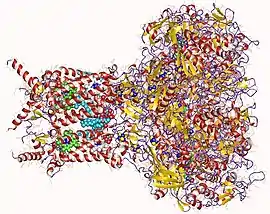| Formate dehydrogenase N, transmembrane | |||||||||||
|---|---|---|---|---|---|---|---|---|---|---|---|
 Formate dehydrogenase-N hetero9mer, E.Coli | |||||||||||
| Identifiers | |||||||||||
| Symbol | Form-deh_trans | ||||||||||
| Pfam | PF09163 | ||||||||||
| InterPro | IPR015246 | ||||||||||
| SCOP2 | 1kqf / SCOPe / SUPFAM | ||||||||||
| OPM superfamily | 3 | ||||||||||
| OPM protein | 1kqf | ||||||||||
| |||||||||||
Formate dehydrogenases are a set of enzymes that catalyse the oxidation of formate to carbon dioxide, donating the electrons to a second substrate, such as NAD+ in formate:NAD+ oxidoreductase (EC 1.17.1.9) or to a cytochrome in formate:ferricytochrome-b1 oxidoreductase (EC 1.2.2.1).[1] This family of enzymes has attracted attention as inspiration or guidance on methods for the carbon dioxide fixation, relevant to global warming.[2]
Function
NAD-dependent formate dehydrogenases are important in methylotrophic yeast and bacteria, being vital in the catabolism of C1 compounds such as methanol.[3] The cytochrome-dependent enzymes are more important in anaerobic metabolism in prokaryotes.[4] For example, in E. coli, the formate:ferricytochrome-b1 oxidoreductase is an intrinsic membrane protein with two subunits and is involved in anaerobic nitrate respiration.[5][6]
NAD-dependent reaction
Formate + NAD+ ⇌ CO2 + NADH + H+
Cytochrome-dependent reaction
Formate + 2 ferricytochrome b1 ⇌ CO2 + 2 ferrocytochrome b1 + 2 H+
Molybdopterin, molybdenum and selenium dependence
The metal-dependent Fdh's feature Mo or W at their active sites. These active sites resemble the motif seen in DMSO reductase, with two molybdopterin cofactors bound to Mo/W in a bidentate fashion. The fifth and sixth ligands are sulfide and either cysteinate or selenocysteinate.[7]
The mechanism of action appears to involve 2e redox of the metal centers, induced by hydride transfer from formate and release of carbon dioxide:
- S=MVI(Scys)(SR)4 + HCO−2 ⇌ HS−MIV(Scys)(SR)4 + CO2
- S=MVI(Secys)(SR)4 + HCO−2 ⇌ HS−MIV(Secys)(SR)4 + CO2
In this scheme, (SR)4 represents the four thiolate-like ligands provided by the two dithiolene cofactors, the molybdopterins. The dithiolene and cysteinyl/selenocysteinyl ligands are redox-innocent. In terms of the molecular details, the mechanism remains uncertain, despite numerous investigations. Most mechanisms assume that formate does not coordinate to Mo/W, in contrast to typical Mo/W oxo-transferases (e.g., DMSO reductase). A popular mechanistic proposal entails transfer of H- from formate to the Mo/WVI=S group.[8]
.png.webp)
Transmembrane domain
Formate dehydrogenase consists of two transmembrane domains; three α-helices of the β-subunit and four transmembrane helices from the gamma-subunit.
The β-subunit of formate dehydrogenase is present in the periplasm with a single transmembrane α-helix spanning the membrane by anchoring the β-subunit to the inner-membrane surface. The β-subunit has two subdomains, where each subdomain has two [4Fe-4S] ferredoxin clusters. The judicious alignment of the [4Fe-4S] clusters in a chain through the subunit have low separation distances, which allow rapid electron flow through [4Fe-4S]-1, [4Fe-4S]-4, [4Fe-4S]-2, and [4Fe-4S]-3 to the periplasmic heme b in the γ-subunit. The electron flow is then directed across the membrane to a cytoplasmic heme b in the γ-subunit .
The γ-subunit of formate dehydrogenase is a membrane-bound cytochrome b consisting of four transmembrane helices and two heme b groups which produce a four-helix bundle which aids in heme binding. The heme b cofactors bound to the gamma subunit allow for the hopping of electrons through the subunit. The transmembrane helices maintain both heme b groups, while only three provide the heme ligands thereby anchoring Fe-heme. The periplasmic heme b group accepts electrons from [4Fe-4S]-3 clusters of the β-subunit’s periplasmic domain. The cytoplasmic heme b group accepts electrons from the periplasmic heme b group, where electron flow is then directed towards the menaquinone (vitamin K) reduction site, present in the transmembrane domain of the gamma subunit. The menaquinone reduction site in the γ-subunit, accepts electrons through the binding of a histidine ligand of the cytoplasmic heme b.[9]

See also
Additional reading
- Ferry JG (1990). "Formate dehydrogenase". FEMS Microbiol. Rev. 7 (3–4): 377–82. doi:10.1111/j.1574-6968.1990.tb04940.x. PMID 2094290.
References
- ↑ Hille, Russ; Hall, James; Basu, Partha (2014). "The Mononuclear Molybdenum Enzymes". Chemical Reviews. 114 (7): 3963–4038. doi:10.1021/cr400443z. PMC 4080432. PMID 24467397.
- ↑ Amao, Yutaka (2018). "Formate dehydrogenase for CO2 utilization and its application". Journal of CO2 Utilization. 26: 623–641. doi:10.1016/j.jcou.2018.06.022. S2CID 189383769.
- ↑ Popov VO, Lamzin VS (1994). "NAD(+)-dependent formate dehydrogenase". Biochem. J. 301 (3): 625–43. doi:10.1042/bj3010625. PMC 1137035. PMID 8053888.
- ↑ Jormakka M, Byrne B, Iwata S (2003). "Formate dehydrogenase--a versatile enzyme in changing environments". Curr. Opin. Struct. Biol. 13 (4): 418–23. doi:10.1016/S0959-440X(03)00098-8. PMID 12948771.
- ↑ Graham A, Boxer DH (1981). "The organization of formate dehydrogenase in the cytoplasmic membrane of Escherichia coli". Biochem. J. 195 (3): 627–37. doi:10.1042/bj1950627. PMC 1162934. PMID 7032506.
- ↑ Ruiz-Herrera J, DeMoss JA (1969). "Nitrate reductase complex of Escherichia coli K-12: participation of specific formate dehydrogenase and cytochrome b1 components in nitrate reduction". J. Bacteriol. 99 (3): 720–9. doi:10.1128/JB.99.3.720-729.1969. PMC 250087. PMID 4905536.
- ↑ Stripp, Sven T.; Duffus, Benjamin R.; Fourmond, Vincent; Léger, Christophe; Leimkühler, Silke; Hirota, Shun; Hu, Yilin; Jasniewski, Andrew; Ogata, Hideaki; Ribbe, Markus W. (2022). "Second and Outer Coordination Sphere Effects in Nitrogenase, Hydrogenase, Formate Dehydrogenase, and CO Dehydrogenase". Chemical Reviews. 122 (14): 11900–11973. doi:10.1021/acs.chemrev.1c00914. PMC 9549741. PMID 35849738.
- ↑ Fogeron, Thibault; Li, Yun; Fontecave, Marc (2022). "Formate Dehydrogenase Mimics as Catalysts for Carbon Dioxide Reduction". Molecules. 27 (18): 5989. doi:10.3390/molecules27185989. PMC 9506188. PMID 36144724.
- ↑ Stiefel, Edward (2002-03-31). "Faculty Opinions recommendation of Molecular basis of proton motive force generation: structure of formate dehydrogenase-N". doi:10.3410/f.1004770.61154.
{{cite journal}}: Cite journal requires|journal=(help)